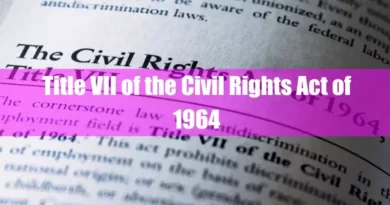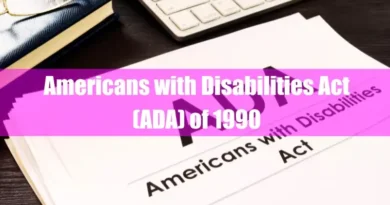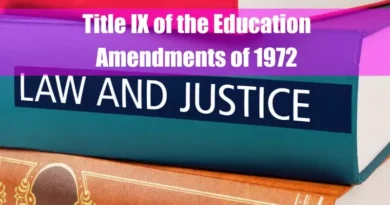Legal Foundations of Anti-Harassment Laws in the U.S.
Takeaways
| Key Points |
|---|
| Anti-harassment laws in the United States have evolved as part of the broader civil rights movement, starting with Title VII of the Civil Rights Act of 1964, which prohibits employment discrimination based on race, color, religion, sex, or national origin, and later expanding through key court rulings like Meritor Savings Bank v. Vinson (1986) that recognized sexual harassment as a form of sex discrimination. |
| Federal laws such as the Americans with Disabilities Act (ADA), the Age Discrimination in Employment Act (ADEA), and the Genetic Information Nondiscrimination Act (GINA) further extend protections against harassment based on disability, age, and genetic information, respectively, while state laws provide additional safeguards tailored to local needs. |
| Educational institutions are governed by Title IX of the Education Amendments of 1972, which prohibits sex-based discrimination, including harassment, in federally funded schools, with enforcement overseen by the Office for Civil Rights (OCR). |
| Housing protections fall under the Fair Housing Act (FHA) of 1968, which prevents discrimination in renting, selling, or financing homes, addressing issues like hostile housing environments and discouragement from renting or owning based on protected traits. |
| The enforcement of these laws is carried out by agencies such as the Equal Employment Opportunity Commission (EEOC) and the OCR, while social movements like #MeToo continue to push for stronger protections and awareness to ensure safe and equitable environments across workplaces, schools, and housing. |
Introduction

Anti-harassment laws in the United States have developed as part of a broader movement for civil rights and gender equality. The Civil Rights Act of 1964, particularly Title VII, laid the groundwork by outlawing discrimination based on race, color, religion, sex, or national origin.
The civil rights movement in the 1960s was instrumental in driving this legislation, aiming to dismantle systemic racism and promote equal treatment. Over time, courts began to recognize sexual harassment as a form of sex discrimination, leading to significant rulings like Meritor Savings Bank v. Vinson in 1986.
The 1990s saw further advances with the Civil Rights Act 1991, which strengthened protections and allowed victims to seek compensatory and punitive damages. The #MeToo movement, which gained global attention in 2017, further highlighted the pervasive issue of sexual harassment, leading to renewed calls for stronger enforcement and new legislation.
These movements have been driven by the need to create safe and equitable environments free from discrimination and harassment based on race, gender, or other protected characteristics.
Legal Foundations of Anti-Harassment Laws in the United States
Understanding Harassment and Its Impact
Harassment is unwanted conduct that humiliates, intimidates, or offends a person based on protected characteristics. It can take many forms, including verbal, physical, and visual acts that create a hostile environment. The impact of harassment is profound, affecting victims’ mental and physical well-being, reducing workplace productivity, and undermining educational achievements.
Harassment can lead to anxiety, depression, and even physical health problems. Legally, the aim is to protect individuals from harm, ensuring everyone has the right to participate in work, education, and other public life without fear of discrimination or abuse.

The Complex Legal Landscape
The legal landscape for anti-harassment laws in the United States combines federal and state laws. These laws address different forms of harassment in various contexts, providing a multi-layered framework to cover numerous scenarios and protected groups.
At the federal level, several laws serve as the foundation for anti-harassment protections:
- Title VII of the Civil Rights Act of 1964 prohibits employment discrimination based on race, color, religion, sex, or national origin. This includes sexual harassment and harassment based on other protected characteristics.
- The Americans with Disabilities Act (ADA) of 1990 extends protections to individuals with disabilities, making it illegal to harass someone because of their disability.
- The Age Discrimination in Employment Act (ADEA) of 1967 protects employees and job applicants 40 or older from age-based harassment.
- The Genetic Information Nondiscrimination Act (GINA) of 2008 prohibits harassment based on genetic information, which includes family medical history and the results of genetic tests (EEOC, 2023).
2. State Laws
State laws complement federal laws by providing additional protections and addressing local concerns. States may have laws that cover smaller employers, include more protected categories, or impose stricter penalties for harassment. For instance, some states have specific protections against discrimination based on sexual orientation or gender identity, which may not be explicitly covered under federal law.
This variation ensures that protections can be tailored to reflect the values and needs of different communities nationwide.
Title VII of the Civil Rights Act of 1964

Prohibition of Discrimination in Employment
“Title VII prohibits discrimination in all aspects of employment, including hiring, firing, promotions, pay, and other conditions of employment. It applies to employers with 15 or more employees, including federal, state, and local governments, labor organizations, and employment agencies.”
The law was established to eliminate workplace discrimination, which was rampant in the mid-20th century, especially against African Americans and women.
Title VII aimed to create a more equitable workforce by making discrimination illegal.
Sexual Harassment as a Form of Sex Discrimination
Sexual harassment is recognized under Title VII as a form of sex discrimination. It includes:
- Quid Pro Quo Harassment occurs when submission to or rejection of unwelcome sexual conduct is used as the basis for employment decisions, such as promotions or job assignments.
- Hostile Work Environment occurs when unwelcome conduct based on sex is so severe or pervasive that it creates a work environment that a reasonable person would find intimidating, hostile, or abusive.
Sexual harassment laws were significantly shaped by several key court rulings, including the 1986 Supreme Court case Meritor Savings Bank v. Vinson, which established that a hostile work environment constitutes a violation of Title VII.
Key Provisions of Title VII for Anti-Harassment
Title VII outlines several important provisions for addressing harassment:
- Employer Responsibility: Employers are responsible for preventing harassment and are liable if they fail to take appropriate action when they know or should have known about harassment in the workplace. This provision emphasizes the duty of employers to maintain a safe work environment.
- Anti-Retaliation: Title VII prohibits retaliation against employees who report discrimination, file a complaint, or participate in an investigation. This protection ensures that employees can exercise their rights without fear of negative consequences.
Enforcement by the Equal Employment Opportunity Commission (EEOC)
The EEOC enforces Title VII and other federal anti-discrimination laws. The EEOC investigates complaints, mediates disputes, and can file lawsuits on behalf of employees. The EEOC’s role is critical in ensuring compliance with anti-harassment laws and providing recourse for victims of discrimination.
Over the years, the EEOC has developed extensive guidelines and resources to help employers understand and fulfill their legal obligations.
Expanding Protections Beyond Title VII

The Americans with Disabilities Act (ADA) of 1990 (Disability-Based Harassment)
“The ADA prohibits discrimination against qualified individuals with disabilities and requires employers to provide reasonable accommodations unless doing so would cause undue hardship.” Disability-based harassment occurs when an individual is subjected to unwelcome conduct because of their disability, creating a hostile work environment.
The ADA was a response to widespread exclusion and discrimination against disabled individuals, aiming to promote inclusion and accessibility in all aspects of public life.
The Age Discrimination in Employment Act (ADEA) of 1967 (Age-Based Harassment)
“The ADEA protects workers aged 40 and older from discrimination based on age. Age-based harassment involves unwelcome comments or actions that create an offensive or hostile work environment for older employees.”
The ADEA was enacted to counteract stereotypes that older workers are less capable or less valuable, ensuring that employment decisions are based on ability rather than age.
The Genetic Information Nondiscrimination Act (GINA) of 2008 (Genetic Information-Based Harassment)
“GINA prohibits discrimination based on genetic information, which includes an individual’s genetic tests, the genetic tests of family members, and family medical history. Genetic information-based harassment occurs when an individual is subjected to unwelcome conduct because of their genetic information, creating a hostile work environment.”
GINA was enacted to protect individuals from discrimination based on genetic predispositions, reflecting concerns about the potential misuse of genetic data.
Anti-Harassment Laws in Educational Settings

Title IX of the Education Amendments of 1972 (Sex-Based Harassment in Schools)
“Title IX prohibits sex-based discrimination in any education program or activity receiving federal financial assistance. This includes sexual harassment, which is considered a form of sex discrimination under Title IX. The law applies to all public and private educational institutions that receive federal funds.”
Title IX was enacted to promote gender equality in education, ensuring all students have equal educational opportunities regardless of sex.
Enforcement Mechanisms for Title IX Violations
The Office for Civil Rights (OCR) of the U.S. Department of Education enforces Title IX. The OCR investigates complaints, monitors compliance, and can withdraw federal funding from institutions that fail to adhere to Title IX requirements. Enforcement of Title IX has evolved over the years, with significant developments including introducing more stringent requirements for handling sexual harassment complaints in educational institutions.
Anti-Harassment Protections in Housing

The Fair Housing Act (FHA) of 1968 (Prohibition on Housing Discrimination)
The FHA prohibits discrimination in the sale, rental, and financing of dwellings based on race, color, national origin, religion, sex, familial status, or disability. It was enacted in response to pervasive housing discrimination that limited where people could live based on their race and other characteristics.
The FHA aims to ensure that everyone has equal access to housing opportunities.
How the FHA Applies to Harassment in Housing
The FHA addresses harassment in housing in two main ways:
Hostile Housing Environment: This occurs when unwelcome conduct based on a protected characteristic creates a hostile or offensive living environment. This could include racial slurs, threats, or other discriminatory behaviors that interfere with a person’s ability to enjoy their home.
Discouragement from Renting or Owning: Refers to actions that deter individuals from renting or owning property based on their protected characteristics. This could include making discriminatory statements or imposing different terms and conditions based on a person’s race, sex, or other protected traits.
Limitations and Considerations

Exemptions from Anti-Harassment Laws
Some entities may be exempt from certain federal anti-harassment laws. For example, Title VII generally applies to employers with 15 or more employees, and the ADEA applies to employers with 20 or more employees.
Religious organizations may also have exemptions regarding employment discrimination based on religious beliefs. These exemptions reflect a balance between protecting individuals from discrimination and recognizing the autonomy of certain protections.
These exemptions can limit the scope of individuals’ protection in certain scenarios, underscoring the importance of understanding federal and state-specific laws.
The Importance of Employer Policies and Procedures
While federal and state laws provide a framework for anti-harassment protections, effective enforcement often depends on employer policies and procedures. Employers must establish anti-harassment policies, provide regular employee training, and implement effective complaint procedures.
Robust policies help prevent harassment and ensure prompt and appropriate responses when it occurs. An employer’s proactive stance can also minimize legal liabilities and foster a respectful workplace culture.
Individual State Laws and Additional Protections
State laws can offer additional protections beyond those provided by federal laws. For example, some states have laws that protect against discrimination based on sexual orientation, gender identity, marital status, and other characteristics that may not be explicitly covered under federal law.
State laws may also have different standards for what constitutes harassment or different procedural requirements for filing complaints. These variations highlight the importance of understanding the specific legal protections available in each state.
Why Are Laws Evolving?

Laws evolve to address changes in societal norms, technology, and understandings of harassment and discrimination. Key factors driving legal changes include:
- Increased Advocacy: Movements like #MeToo have heightened public awareness of harassment, leading to stronger calls for legal protections and enforcement.
- Evolving Norms: Actions once acceptable may now be considered harmful, necessitating laws updating to match current standards.
- New Forms of Harassment: Digital platforms have introduced harassment types like cyberbullying and online stalking, requiring new legal frameworks.
- Privacy Issues: The misuse of technology has led to new privacy concerns and forms of harassment, prompting the need for updated laws.
- Broadening Definitions: Laws now recognize harassment based on race, religion, age, disability, sexual orientation, and more, extending protections beyond sexual harassment.
- Intersectionality: Legal protections are expanding to consider multiple forms of discrimination affecting individuals simultaneously.
- Legal Gaps: Emerging forms of harassment reveal gaps in existing laws, prompting new legislation.
- Enforcement Improvements: Enhancing enforcement mechanisms ensures that legal protections are effective.
- Judicial Influence: Court rulings often highlight ambiguities in the law, prompting revisions and clarifications.
- Global Influence: International human rights standards and comparisons with other countries’ laws can prompt domestic legal updates.
- Ongoing Input: Research and advocacy from civil society groups highlight the need for legal reforms to address emerging issues effectively.
Key Challenges

Anti-harassment laws in the United States face several challenges:
- Vague Definitions: Broad or more specific legal definitions can lead to consistent interpretations and enforcement.
- Subjectivity: Harassment is often subjective, making determining when behavior crosses the line difficult.
- Inconsistent Protections: Differences in state laws must be clarified, and protections and enforcement must be consistent.
- Variable Enforcement: State differences in penalties and enforcement can result in uneven victim protection.
- Underreporting: Fear of retaliation and lack of trust in the system lead many victims to avoid reporting harassment.
- Burden of Proof: Proving harassment can be challenging due to the subjective nature of evidence.
- New Harassment Forms: Digital communication and social media have introduced harassment types not covered by existing laws.
- Rapid Norm Changes: Laws may struggle to keep pace with evolving social norms around acceptable behavior.
- Policy Development: Employers face challenges in developing effective, enforceable anti-harassment policies.
- Training Gaps: Lack of adequate training on harassment laws can lead to gaps in awareness and understanding.
- Minimizing Attitudes: Cultural attitudes that dismiss harassment hinder effective legal enforcement.
- Systemic Discrimination: Addressing harassment often requires confronting broader systemic biases and inequalities.
- Complex Discrimination: Laws must account for intersectional harassment, but doing so is complex due to the varied forms of discrimination.
These challenges necessitate continuously evaluating and adapting anti-harassment laws to ensure they effectively protect individuals in a changing world.
Conclusion
Anti-harassment laws are crucial in promoting equality and preventing discrimination in the United States. They provide legal recourse for victims, help deter unacceptable behaviors, and establish clear standards for conduct in various settings. As society evolves, these laws must be adapted and enforced to address new forms of harassment and discrimination.
Looking forward, there are ongoing efforts to strengthen and expand anti-harassment protections. For example, the Debbie Smith Act of 2004 was enacted to address the backlog of untested DNA evidence in sexual assault cases, ensuring timely justice for victims.
Meanwhile, the PROTECT Act of 2003 includes provisions to prevent the exploitation and abuse of minors, reflecting a broader commitment to protecting vulnerable individuals from harassment and abuse.
These laws demonstrate the dynamic nature of anti-harassment legislation and the need for continuous advocacy and legislative action to protect all individuals from harassment and discrimination. As society’s understanding of harassment evolves, so must the laws that seek to prevent it, ensuring a safe and equitable environment for everyone.
FAQ
What is the legal definition of harassment under U.S. federal law?
Harassment is unwelcome conduct based on protected characteristics like race, color, religion, sex, national origin, age, disability, or genetic information. It becomes unlawful when enduring it becomes a condition of continued employment or when it creates a work environment that a reasonable person would consider intimidating, hostile, or abusive.
Which federal laws prohibit workplace harassment?
Key federal laws include Title VII of the Civil Rights Act of 1964, the Age Discrimination in Employment Act (ADEA), the Americans with Disabilities Act (ADA), and the Genetic Information Nondiscrimination Act (GINA). These laws collectively prohibit harassment based on various protected characteristics.
How did the Civil Rights Act of 1964 influence anti-harassment laws?
The Civil Rights Act of 1964, particularly Title VII, laid the foundation by prohibiting employment discrimination based on race, color, religion, sex, or national origin, thereby addressing various forms of workplace harassment.
What role does the Equal Employment Opportunity Commission (EEOC) play in enforcing anti-harassment laws?
The EEOC enforces federal laws prohibiting employment discrimination. It investigates harassment complaints, mediates disputes, issues guidelines, and can file lawsuits on behalf of employees against employers.
How do state anti-harassment laws interact with federal laws?
State laws may offer broader protections than federal laws, covering additional protected classes, smaller employers, or imposing stricter penalties. Employers must comply with both federal and applicable state laws.
What is the significance of the Meritor Savings Bank v. Vinson (1986) case?
This Supreme Court case recognized sexual harassment as a violation of Title VII, establishing that a hostile work environment constitutes unlawful discrimination.
Are employers liable for harassment by non-employees?
Yes, employers can be held liable if they knew or should have known about the harassment by non-employees (e.g., customers or clients) and failed to take immediate and appropriate corrective action.
Does federal law protect against harassment based on sexual orientation or gender identity?
While Title VII doesn’t explicitly mention sexual orientation or gender identity, the EEOC interprets discrimination based on sex to include these categories. However, protections can vary, and some states have explicit laws addressing this form of harassment.
What constitutes a hostile work environment?
A hostile work environment occurs when unwelcome conduct based on protected characteristics is severe or pervasive enough that a reasonable person would find it intimidating, hostile, or abusive.
What is quid pro quo harassment?
Quid pro quo harassment involves conditioning employment benefits on submission to unwelcome sexual conduct—for example, a supervisor offering a promotion in exchange for sexual favors.
Are small businesses subject to federal anti-harassment laws?
Title VII applies to employers with 15 or more employees. However, state or local laws may cover smaller employers, so it’s essential to consult local regulations.
Can harassment occur outside the physical workplace?
Yes, harassment can occur in any work-related context, including off-site events, business trips, or virtual environments like emails and video calls. The key factor is the connection to the work environment.
What protections exist for employees who report harassment?
Federal laws prohibit retaliation against employees who report harassment, file a discrimination charge, or participate in an investigation or lawsuit. Retaliation can include adverse actions like demotion, termination, or other forms of discrimination.
How does the Americans with Disabilities Act (ADA) address harassment?
The ADA prohibits employment discrimination, including harassment, against qualified individuals with disabilities. It mandates reasonable accommodations and protects against unwelcome conduct that creates a hostile work environment due to disability.
What steps can employers take to prevent harassment?
Employers should establish clear anti-harassment policies, provide regular training, implement effective complaint procedures, and take prompt corrective action when harassment occurs. Creating a culture of respect and zero tolerance for harassment is crucial.









